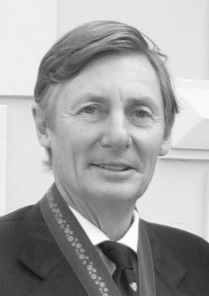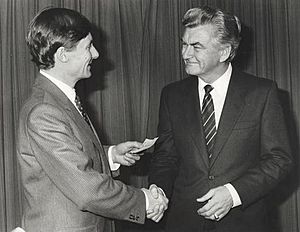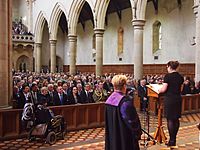John Bannon facts for kids
Quick facts for kids
Dr John Bannon
|
|
|---|---|

Bannon in 2007
|
|
| 39th Premier of South Australia Elections: 1982, 1985, 1989 |
|
| In office 10 November 1982 – 4 September 1992 |
|
| Monarch | Elizabeth II |
| Governor | Sir Donald Dunstan Dame Roma Mitchell |
| Deputy | John Wright (1982–1985) Don Hopgood (1985–1992) |
| Preceded by | David Tonkin |
| Succeeded by | Lynn Arnold |
| President of the Australian Labor Party | |
| In office 7 April 1988 – 25 June 1991 |
|
| Preceded by | Mick Young |
| Succeeded by | Stephen Loosley |
| Leader of the Opposition of South Australia |
|
| In office 2 October 1979 – 10 November 1982 |
|
| Premier | David Tonkin |
| Deputy | Jack Wright |
| Preceded by | Des Corcoran |
| Succeeded by | John Olsen |
| Leader of the South Australian Labor Party |
|
| In office 2 October 1979 – 4 September 1992 |
|
| Preceded by | Des Corcoran |
| Succeeded by | Lynn Arnold |
| Treasurer of South Australia | |
| In office 10 November 1982 – 4 September 1992 |
|
| Premier | John Bannon |
| Preceded by | David Tonkin |
| Succeeded by | Frank Blevins |
| Member of the South Australian House of Assembly for Ross Smith |
|
| In office 17 September 1977 – 10 December 1993 |
|
| Preceded by | Jack Jennings |
| Succeeded by | Ralph Clarke |
| Personal details | |
| Born |
John Charles Bannon
7 May 1943 Bendigo, Victoria |
| Died | 13 December 2015 (aged 72) Adelaide, South Australia |
| Nationality | Australian |
| Political party | Australian Labor Party (SA) |
| Alma mater | University of Adelaide (BA, LLB) Flinders University (PhD) |
John Charles Bannon (7 May 1943 – 13 December 2015) was an Australian politician and a university professor. He served as the 39th Premier of South Australia. This means he was the leader of the state government.
He led the Labor Party in South Australia. He helped them win back power in the 1982 election. His government was re-elected in 1985. In 1992, he became Labor's longest-serving Premier in South Australia. He resigned as Premier in 1992 because of problems with the State Bank of South Australia. He left parliament in 1993.
Contents
Early Life and Education
John Bannon was born in Bendigo, Victoria. He went to primary school in East Adelaide and then to St Peter's College in Adelaide. He studied Arts and Law at the University of Adelaide.
While at university, he was very active. He was a co-editor of the student newspaper On Dit. He also led the student council and the university union. In 1968, he was president of the National Union of Australian University Students. After finishing his studies, he worked as an advisor to different governments.
Political Career
John Bannon was elected to the South Australian House of Assembly in 1977. He represented the area of Ross Smith. Within a year, he became part of the government's cabinet.
After Labor lost the 1979 election, Bannon became the leader of the Labor Party. The economy was struggling in the early 1980s. Bannon managed to lead Labor back to power in the 1982 election. They won by a small number of seats.
Key Achievements as Premier

As Premier, Bannon focused on improving the economy. His government helped with several big projects:
- The Olympic Dam copper and uranium mine.
- A project to build submarines.
- Growth in the defence industry.
- The Hyatt and Adelaide Casino complex.
- Turning part of the Adelaide railway station into the Adelaide Convention Centre.
- Building the O-Bahn Busway for public transport.
- Hosting the Formula One Grand Prix.
His government also sold land that was planned for freeways. They also introduced Poker machines in South Australia. Other actions included protecting plants and improving city areas.
Re-election and Challenges
The economy got better in 1983-84. Bannon's government was easily re-elected in the 1985 election. They won more seats this time.
However, the economy faced problems again in the late 1980s and early 1990s. In the 1989 election, Labor lost some support. Both major parties won the same number of seats. Labor had to form a minority government. This meant they needed support from independent politicians to stay in power.
In April 1988, Bannon was also chosen as the Federal President of the Labor Party. He held this important role until June 1991.
State Bank Issues and Resignation
Problems arose with the State Bank of South Australia. The government was responsible for the bank's loans. John Bannon stayed on as Premier during several investigations into the bank. These investigations found that he had not done anything wrong on purpose.
After these events, he decided to resign as Premier in 1992. He also announced he would not run for parliament again in the next election. Lynn Arnold took over as Premier. However, the Labor Party suffered a big loss in the 1993 election.
Later Life and Academic Career
After leaving politics, John Bannon joined the Australian Broadcasting Corporation in 1994. He was interested in South Australian history. He studied at Flinders University and earned a PhD in Australian political history. He became a professor there.
He was also a professor at the University of Adelaide Law School. In 2014, he received an honorary doctorate from the University of Adelaide. From 2000 to 2007, he was the Master of St Mark's College in Adelaide. In 2007, he was given the Officer of the Order of Australia award. He also wrote a book called Supreme Federalist: The political life of Sir John Downer.
Personal Life
John Bannon had a daughter, Victoria, with his first wife, Robyn Layton. His second wife, Angela, is the mother of TV personality Dylan Lewis.
Bannon was a very good runner. He completed the Adelaide Marathon 28 times. He even ran it in under 3 hours 11 times. His best marathon time was 2 hours, 44 minutes, and 34 seconds in 1983, while he was Premier.
Death
John Bannon passed away from cancer on 13 December 2015. He was 72 years old. He was active right up until his death. A state funeral was held for him on 21 December 2015.



